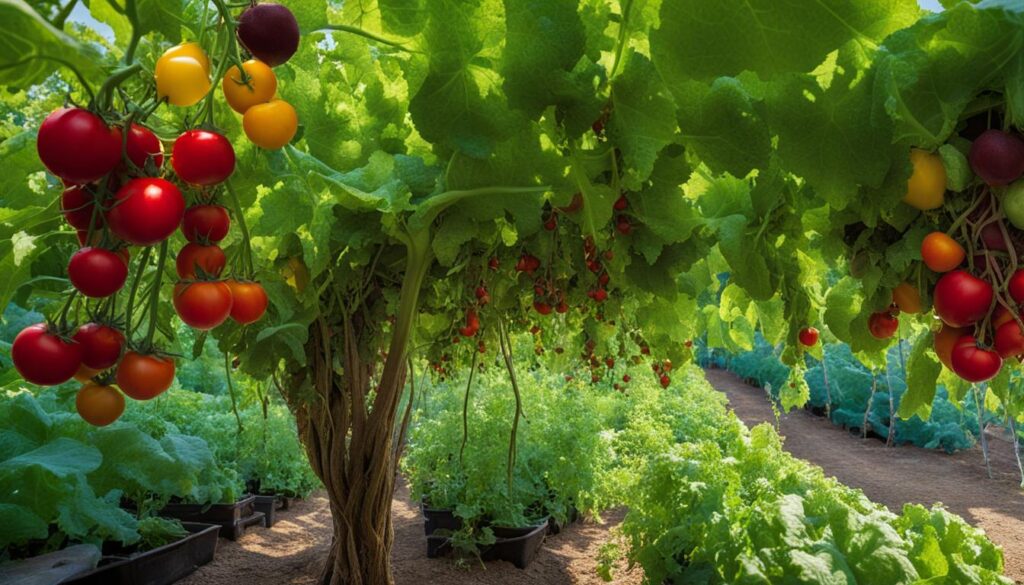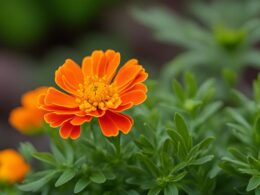Not every gardener has access to a sunny spot for growing vegetables. However, there are several shade-tolerant vegetables that can thrive in partially shaded areas. These vegetables not only tolerate shade but also offer benefits such as relief from intense summer heat and the ability to have early and late harvests. With the right knowledge, you can make the most of your shady garden spots and enjoy a bountiful harvest.
Key Takeaways
- Shade-tolerant vegetables can thrive in partially shaded areas.
- These vegetables offer relief from intense summer heat and allow for early and late harvests.
- Understanding sun exposure is important for determining the best vegetables to grow in each area.
- Leafy greens, brassica vegetables, root vegetables, and beans and peas are some examples of shade-tolerant vegetables.
- With proper gardening techniques, you can maximize your shade garden’s harvest and enjoy fresh vegetables.
Understanding Sun Exposure: Full Sun, Partial Shade, and Full Shade
Different areas of your yard may have varying levels of sunlight due to trees, buildings, and other factors. It’s important to understand the different levels of sun exposure to determine the best vegetables to grow in each area.
Full sun areas receive at least 6 to 8 hours of direct sunlight each day, providing the ideal conditions for a wide range of vegetables to thrive. These areas are perfect for heat-loving crops like tomatoes, peppers, and melons, as well as sun-loving herbs like basil and rosemary. It’s important to ensure that these areas have well-draining soil and regular irrigation to support the growth of these sun-loving plants.
Partial shade areas receive 3 to 6 hours of direct sunlight each day. These areas are suitable for vegetables that can tolerate some shade but still require a moderate amount of sunlight to grow. Leafy greens like lettuce, spinach, and Swiss chard, as well as brassica vegetables like broccoli and cauliflower, are excellent choices for partial shade gardens. These vegetables can handle the lower light levels and slightly cooler temperatures found in shaded areas.
Full shade areas receive little to no direct sunlight. These areas are typically located under dense tree canopies, near tall buildings, or in narrow side yards with high walls. While growing vegetables in full shade can be challenging, there are still options available. Shade-tolerant vegetables like beets, radishes, and leafy greens can be grown successfully in these areas. It’s important to choose varieties specifically bred for shade tolerance and provide extra care in terms of soil quality, moisture levels, and fertilization to support their growth.
Best Vegetables for Partial Shade
When it comes to growing vegetables in partial shade, there are several options that thrive in these conditions. Leafy greens such as spinach, lettuce, and Swiss chard are excellent choices for shady gardens. These vegetables not only tolerate partial shade but also appreciate relief from intense sunlight, allowing them to maintain a longer growing season.
Brassica vegetables like broccoli, cauliflower, and cabbage are also shade-tolerant and prefer cooler weather. Planting them in partially shaded areas can help extend their growing season and protect them from scorching heat. These vegetables are not only delicious but also packed with essential nutrients, making them a valuable addition to any shade garden.
Root vegetables such as beets and carrots can also be grown in partial shade, although they may take a bit longer to mature compared to their counterparts in full sun. Despite the slower growth, these root vegetables remain flavorful and tender, making the wait worthwhile. Additionally, Asian greens like bok choy and tatsoi thrive in deeply shaded areas and require minimal sun exposure, making them suitable for gardens with limited sunlight.
Benefits of Growing Vegetables in Partial Shade
- Relief from intense summer heat: Partial shade provides a cooler environment for vegetables, reducing the risk of heat stress and bolting.
- Extended growing season: Shady areas often have cooler temperatures, allowing certain vegetables to thrive before or after the peak growing season.
- Versatility in garden planning: Incorporating shade-tolerant vegetables expands your options and maximizes the use of shaded spaces in your garden.
“Growing shade-tolerant vegetables offers an opportunity to utilize areas of your garden that may not receive direct sunlight, turning what might appear as limitations into productive and bountiful spaces.”
With the right selection of shade-tolerant vegetables and proper care, you can create a thriving garden even in partially shaded areas. Remember to provide adequate soil, water, and nutrients to support the growth of these vegetables. Whether you’re growing leafy greens, brassicas, or root vegetables, your shade garden can yield delicious and nutritious produce.
Growing Root Vegetables in Partial Shade
Root vegetables, such as potatoes, beets, and carrots, can thrive in partially shaded areas, providing you with a bountiful harvest even in less sunlit spaces. While these vegetables may take slightly longer to reach maturity in shaded conditions, they will still produce flavorful and tender roots that are well worth the wait.
To successfully grow root vegetables in partial shade, it’s best to direct sow the seeds in early spring when the soil is still cool. Prepare the soil by loosening it and removing any rocks or debris that may hinder root growth. Regular weeding is essential to prevent competition for nutrients from other plants in the area. By keeping the soil moist and providing adequate drainage, you can create an optimal environment for root development.
Harvesting root vegetables can be done before they reach full size, allowing you to enjoy smaller, “baby” versions that are tender and packed with flavor. For example, new potatoes harvested early are known for their buttery texture and delicate taste. Regularly check for signs of readiness such as the roots reaching their mature size or the tops of the vegetables beginning to push through the soil. This ensures that you harvest at the ideal time for peak flavor and freshness.
Leafy Greens for Shade Gardens
When it comes to shade-loving leafy greens, there are several options that can thrive even in areas with limited sunlight. One such vegetable is lettuce, which is known for its ability to grow in shade. Lettuce varieties like butterhead, romaine, and loose-leaf lettuce can be sown directly in the garden in early spring and will appreciate the cooler temperatures provided by the shade. To prevent bolting in leafy greens, it’s important to keep them shaded as the season gets hotter. This can be achieved by planting taller crops or using shade cloth to filter the sunlight.
In addition to lettuce, spinach is another shade-tolerant leafy green that can be grown in partially shaded areas. Spinach prefers cooler temperatures and can be sown in early spring. It’s important to provide adequate moisture to prevent the soil from drying out in the shade. Other shade-loving leafy greens include kale, collard greens, and Swiss chard. These greens can be grown in partial shade and will provide a nutritious addition to your garden harvest.
Remember that while leafy greens are shade-tolerant, they still require some sunlight to grow. Aim for at least 3 to 6 hours of direct or filtered sunlight each day for optimal growth. With proper care and attention to their sunlight needs, you can enjoy a bountiful harvest of shade-loving leafy greens throughout the growing season.
Growing Lettuce in Shade
Lettuce is one of the most popular vegetables to grow in shade gardens due to its ability to tolerate cooler temperatures and partial shade conditions. To successfully grow lettuce in shade, follow these tips:
- Choose the right variety: Look for lettuce varieties that are specifically recommended for shade or partial shade. Butterhead, romaine, and loose-leaf lettuce are good options.
- Plant in early spring: Sow lettuce seeds directly in the garden in early spring, when the soil is workable. Ensure that the soil is well-draining and enriched with compost.
- Provide adequate moisture: Keep the soil consistently moist to prevent the lettuce from wilting or bolting. Water deeply and regularly, especially during hot and dry periods.
- Protect from heat: Use shade cloth or plant taller crops nearby to provide some relief from intense sunlight as the season progresses. This will help prevent the lettuce from bolting and becoming bitter.
- Harvest frequently: Harvest lettuce leaves when they reach the desired size, rather than waiting for a full head to form. This will encourage continuous leaf growth and prevent the plant from going to seed.
Preventing Bolting in Leafy Greens
One of the challenges of growing leafy greens in shade gardens is preventing bolting. Bolting is when the plants start to produce flowers and go to seed prematurely, resulting in bitter-tasting leaves. To prevent bolting in leafy greens, follow these tips:
- Provide adequate shade: Keep your leafy greens shaded as the season gets hotter by planting taller crops nearby or using shade cloth. This will help regulate the temperature and prevent the plants from experiencing stress.
- Ensure consistent moisture: Leafy greens prefer moist soil, so make sure to water them regularly. Avoid allowing the soil to dry out completely, as this can trigger bolting.
- Harvest promptly: Harvest your leafy greens when they reach the desired size. Leaves that are left on the plant for too long can become tough and bitter, increasing the likelihood of bolting.
- Consider succession planting: Instead of planting all your leafy greens at once, stagger your plantings over several weeks. This will ensure a continuous supply of fresh leaves and reduce the risk of bolting due to mature plants.
Beans and Peas for Partial Shade
When it comes to growing vegetables in partially shaded areas, beans and peas are a great choice. While they may require a longer growing season compared to their sun-loving counterparts, both bush beans and peas can thrive in partial shade conditions. One advantage of growing these legumes in containers is the flexibility to move them to areas with more sunlight as needed. This allows you to optimize their sun exposure and ensure optimal growth.
Companion planting can also play a role in the success of beans and peas in partial shade. Planting nasturtiums around the base of the pea and bean plants can help control pests naturally, keeping your plants healthy and thriving. These bright orange and yellow flowers not only add visual interest to your garden but also act as a natural repellent for pests like aphids and whiteflies.
Regular harvesting is essential for beans and peas to encourage continuous growth. By picking the mature pods regularly, you allow the plants to produce new blooms and pods. This will lead to a longer and more abundant harvest. Remember to use sharp garden scissors or pruners to avoid damaging the plants.
Growing Bush Beans in Containers
One of the benefits of growing bush beans in containers is the ability to provide them with the right amount of sunlight. Place the containers in an area that receives at least 3 to 6 hours of direct sunlight per day. If the shade is too dense, consider moving the containers to a sunnier spot. Ensure that the containers have proper drainage to prevent waterlogging, which can lead to root rot. Regular watering is crucial to keep the soil consistently moist.
Companion Planting with Peas
Peas can benefit from companion planting with certain herbs, vegetables, and flowers. Planting aromatic herbs like mint, rosemary, and thyme near peas can help deter pests and attract beneficial insects. Intercropping peas with lettuce, spinach, or radishes is also beneficial as these plants provide shade and moisture to the peas while maximizing garden space. Additionally, planting peas near flowers like marigolds can help repel harmful insects.
Full List of Vegetables That Grow in Shade
When it comes to growing vegetables in shade, you have plenty of options to choose from. Whether you have a partially shaded garden or want to make the most of the shady spots in your yard, there are numerous shade-tolerant vegetables that can thrive without direct sunlight. Here is an alphabetical list of some of the most common vegetables that can grow in shade:
- Arugula
- Asparagus
- Beets
- Broccoli
- Brussels sprouts
- Cabbage
- Carrots
- Cauliflower
- Celery
- Collard greens
- Kale
- Leeks
- Lettuce
- Mustard greens
- Parsnips
- Peas
- Potatoes
- Radishes
- Rhubarb
- Rutabaga
- Scallions
- Spinach
- Swiss chard
- Turnips
- Tatsoi
These shade-tolerant vegetables offer a wide variety of flavors, textures, and nutritional benefits, allowing you to create a diverse garden even in areas with limited sunlight. Whether you’re a fan of leafy greens, root vegetables, or brassica vegetables, there’s something for everyone to enjoy in a shade garden.
Remember, growing vegetables in shade requires some extra care and attention. Make sure to provide well-draining soil, adequate water, and regular maintenance to ensure the best possible growth. With the right knowledge and a little effort, you can cultivate a thriving vegetable garden even in the shadiest corners of your yard.
Growing Vegetables in Shade: Tips and Tricks
If you’re new to growing vegetables in shade, here are some tips and tricks to help you get started:
- Choose the right vegetables: Select shade-tolerant vegetables that are known to perform well in low light conditions. Refer to the list above for some ideas.
- Provide dappled sunlight: While most shade-tolerant vegetables can grow in partial shade, they still need some sunlight to thrive. Opt for areas with dappled sunlight or filtered shade.
- Improve soil fertility: Enhance the fertility of your soil by adding organic matter such as compost or well-rotted manure. This will help provide the necessary nutrients for your shade-loving vegetables.
- Water properly: Shade gardens tend to retain more moisture, so be mindful not to overwater. Check the soil moisture regularly and water only when necessary.
- Monitor for pests and diseases: Shady areas can be more prone to pests and diseases. Keep a close eye on your plants and take necessary steps to prevent and control any issues that may arise.
- Rotate crops: To avoid nutrient depletion and disease buildup, practice crop rotation in your shade garden. Avoid planting the same vegetables in the same spot year after year.
By following these tips and adapting your gardening practices to suit the needs of shade-loving vegetables, you can create a productive and beautiful garden even in areas with limited sunlight. Harness the potential of your shady spaces and enjoy a bountiful harvest of fresh, homegrown vegetables.
Conclusion
By choosing the right shade-tolerant vegetables and employing effective gardening techniques, you can cultivate a flourishing garden in partially shaded areas. Whether you have limited access to sunlight or want to maximize the use of your shade garden, there are plenty of options to consider.
Leafy greens like lettuce, spinach, and kale thrive in partial shade and provide a nutritious addition to your meals. Brassica vegetables such as broccoli and cabbage are also shade-tolerant and can be enjoyed in cooler weather. Root vegetables like beets and carrots may take longer to mature in shaded conditions but can still yield delicious results.
To make the most of your shade garden, it’s essential to understand sun exposure and create microclimates within your space. Planting in the appropriate soil, providing adequate watering, and ensuring good drainage are key aspects of successful gardening in partial shade.
So embrace the challenge of gardening in partially shaded areas and enjoy the benefits of fresh vegetables. With careful planning and proper care, you can maximize your shade garden’s harvest and savor the rewards of your hard work and dedication.
What Vegetables Can I Grow Indoors Without Sunlight During Winter?
When it comes to growing winter vegetables indoors without sunlight, you can consider options like lettuce, spinach, and microgreens. These plants can thrive in low light conditions and are perfect for indoor gardening. Utilize grow lights to provide the necessary light for growing winter vegetables indoors.
FAQ
What are shade-tolerant vegetables?
Shade-tolerant vegetables are varieties that can thrive in partially shaded areas, receiving 3 to 6 hours of direct sunlight each day. These vegetables not only tolerate shade but also offer benefits such as relief from intense summer heat and the ability to have early and late harvests.
How do I determine the level of sun exposure in my yard?
Different areas of your yard may have varying levels of sunlight due to trees, buildings, and other factors. Full sun areas receive at least 6 to 8 hours of direct sunlight each day, while partial shade areas receive 3 to 6 hours of direct sunlight. Full shade areas receive little to no direct sunlight. Additionally, microclimates within your yard can create variations in sun exposure, and it’s important to consider these when planning your vegetable garden.
Which vegetables grow well in partial shade?
Several vegetables thrive in partial shade conditions. Leafy greens such as spinach, lettuce, and Swiss chard grow best in partial shade and can be planted in early spring. Brassica vegetables like broccoli, cauliflower, and cabbage are also shade-tolerant and prefer cooler weather. Additionally, root vegetables such as beets and carrots can be grown in partial shade, though they may take longer to mature. Asian greens like bok choy and tatsoi do exceptionally well in deeply shaded areas and require minimal sun exposure.
Can root vegetables like potatoes be grown in partial shade?
Yes, root vegetables such as potatoes, beets, and carrots can be successfully grown in partial shade. These vegetables may take slightly longer to reach maturity in shaded conditions, but they will still produce flavorful and tender roots. It’s best to direct sow root vegetables in early spring and ensure that the soil is loose and free from rocks. Regular weeding is necessary to prevent competition for nutrients. Harvesting root vegetables can be done before they reach full size to enjoy smaller, “baby” versions if desired.
What are the best leafy greens for shade gardens?
Leafy greens like lettuce, spinach, and kale thrive in partial shade and can tolerate cooler temperatures. These vegetables should be planted in early spring and can be sown directly in the garden. Keeping leafy greens shaded as the season gets hotter helps them last longer and prevents early bolting. Lettuce, for example, is content being planted in a shady spot and can be harvested continuously as needed.
Can beans and peas be grown in partial shade?
Yes, beans and peas can be grown in partial shade, though they may require a longer growing season. Both bush beans and peas grow well in pots and containers, allowing you to move them to areas with more sunlight as needed. Planting nasturtiums around the base of the pea and bean plants can help control pests. It’s important to harvest beans and peas regularly to encourage continued growth.
What are some other vegetables that can grow in shade?
There is a wide range of vegetables that can grow in shade. Some of the most common shade-tolerant vegetables include arugula, asparagus, beets, broccoli, Brussels sprouts, cabbage, carrots, cauliflower, celery, collard greens, kale, leeks, lettuce, mustard greens, parsnips, peas, potatoes, radishes, rhubarb, rutabaga, scallions, spinach, Swiss chard, turnips, and tatsoi. These vegetables offer different flavors and nutritional benefits, allowing you to create a diverse garden even in shady areas.
How can I maximize my shade garden’s harvest?
With the right selection of shade-tolerant vegetables and proper gardening techniques, you can successfully grow a thriving garden in partially shaded areas. Understanding sun exposure, creating microclimates within your garden, and providing good soil and appropriate watering are key factors in maximizing your shade garden’s harvest. Embrace the challenge and enjoy the benefits of fresh vegetables even in partially shaded garden spaces.












